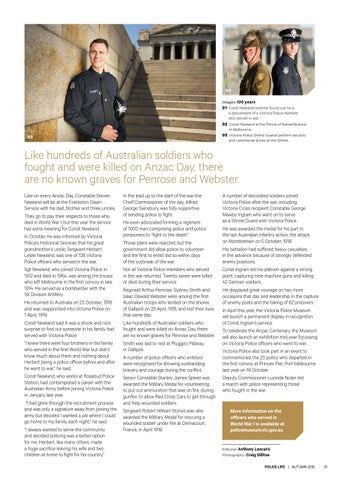03 Images 100 years 01 Const Newland recently found out he is a descendant of a Victoria Police member who served in war. 02 Const Newland at the Shrine of Remembrance in Melbourne. 03 Victoria Police Shrine Guards perform security and ceremonial duties at the Shrine.
02
Like hundreds of Australian soldiers who fought and were killed on Anzac Day, there are no known graves for Penrose and Webster. Like on every Anzac Day, Constable Steven Newland will be at the Frankston Dawn Service with his dad, brother and three uncles. They go to pay their respects to those who died in World War I, but this year the service has extra meaning for Const Newland. In October, he was informed by Victoria Police’s Historical Services that his great grandmother’s uncle, Sergeant Herbert Leslie Newland, was one of 138 Victoria Police officers who served in the war. Sgt Newland, who joined Victoria Police in 1912 and died in 1964, was among the troops who left Melbourne in the first convoy in late 1914. He served as a bombardier with the 1st Division Artillery. He returned to Australia on 23 October, 1918 and was reappointed into Victoria Police on 1 April, 1919. Const Newland said it was a shock and nice surprise to find out someone in his family had served with Victoria Police. “I knew there were four brothers in the family who served in the first World War but didn’t know much about them and nothing about Herbert being a police officer before and after he went to war,” he said. Const Newland, who works at Rosebud Police Station, had contemplated a career with the Australian Army before joining Victoria Police in January last year. “I had gone through the recruitment process and was only a signature away from joining the army but decided I wanted a job where I could go home to my family each night,” he said. “I always wanted to serve the community and decided policing was a better option for me. Herbert, like many others, made a huge sacrifice leaving his wife and two children at home to fight for his country.”
In the lead up to the start of the war the Chief Commissioner of the day, Alfred George Sainsbury, was fully supportive of sending police to fight. He even advocated forming a regiment of 1000 men comprising police and police pensioners to “fight to the death”. Those plans were rejected, but the government did allow police to volunteer and the first to enlist did so within days of the outbreak of the war. Not all Victoria Police members who served in the war returned. Twenty seven were killed or died during their service. Reginald Arthur Penrose, Sydney Smith and Isaac Oswald Webster were among the first Australian troops who landed on the shores of Gallipoli on 25 April, 1915, and lost their lives that same day. Like hundreds of Australian soldiers who fought and were killed on Anzac Day, there are no known graves for Penrose and Webster. Smith was laid to rest at Plugge’s Plateau in Gallipoli. A number of police officers who enlisted were recognised for showing outstanding bravery and courage during the conflict. Senior Constable Stanley James Speed was awarded the Military Medal for volunteering to put out ammunition that was on fire, during gunfire, to allow Red Cross Cars to get through and help wounded soldiers. Sergeant Robert William Stynes was also awarded the Military Medal for rescuing a wounded soldier under fire at Dernacourt, France, in April 1918.
A number of decorated soldiers joined Victoria Police after the war, including Victoria Cross recipient Constable George Mawby Ingram who went on to serve as a Shrine Guard with Victoria Police. He was awarded the medal for his part in the last Australian infantry action, the attack on Montbrehain on 5 October, 1918. His battalion had suffered heavy casualties in the advance because of strongly defended enemy positions. Const Ingram led his platoon against a strong point, capturing nine machine guns and killing 42 German soldiers. He displayed great courage on two more occasions that day and leadership in the capture of enemy posts and the taking of 62 prisoners. In April this year, the Victoria Police Museum will launch a permanent display in recognition of Const Ingram’s service. To celebrate the Anzac Centenary, the Museum will also launch an exhibition mid-year focussing on Victoria Police officers who went to war. Victoria Police also took part in an event to commemorate the 20 police who departed in the first convoy at Princes Pier, Port Melbourne last year on 19 October. Deputy Commissioner Lucinda Nolan led a march with police representing those who fought in the war.
More information on the officers who served in World War I is available at policemuseum.vic.gov.au
Editorial: Anthony Loncaric Photography: Craig Sillitoe POLICE LIFE | AUTUMN 2015
31
